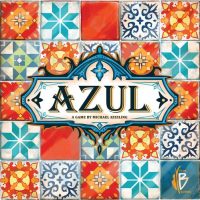
Azul
Azul was designed by the world famous, award winning game author Michael Kiesling. Azul captures the beautiful aesthetics of Moorish art in a contemporary board game. Players compete as artisans decorating the walls of the Royal Palace of Evora. By carefully drafting the correct quantity and style of tiles, the most clever of artisans plan ahead to maximize the beauty of their work (not to mention their scores!) while ensuring they wasted no supplies in the process.
Introduced by the Moors, “azulejos” (originally white and blue ceramic tiles) were fully embraced by the Portuguese, when their King Manuel I, on a visit to the Alhambra palace in Southern Spain, was mesmerized by the stunning beauty of the Moorish decorative tiles. The king, awestruck by the interior beauty of the Alhambra, immediately ordered that his own palace in Portugal be decorated with similar wall tiles.
Azul is suited for 2 – 4 artisans, ages 8+. While the actual decoration of the Royal Palace of Evora took many years, we expect a game of Azul to last 30 – 40 minutes.
User Reviews (3)
Add a Review for "Azul"
You must be logged in to add a review.

So Azul is an abstract strategy where you’re placing tiles to complete rows on your personal player board in order to move it to your finished wall and score points. You score points by counting orthogonal connections to the tile you just place. The game play is simple, you take a color (all of that color) from any factory you choose (these are small circular coasters) and the remainder of the tiles go to the middle of the factory floor (aka your table). Then you place the tiles you just took to your preparation area of your player board. At the end of the round (once all the times available have been taken) you move the right most tile from any completed row in your preparation area to the finished wall on the right side of your player board and score it appropriately.
The rules are simple, the game is beautiful, and the replay is fantastic. The components consist of slick plastic tiles of various decorations, a decent quality player board, a nice bag to draw the tiles from, some card board coasters to represent factories, and some small cubes to track your scoring. All the components are of nice quality and visually add to the overall look of you decorating a wall in the Royal Palace of Evora.
I highly recommend this game, even if you don’t consider yourself an abstract strategy gamer. I also recently played it with a new gamer, when I asked what type games he likes, he said Uno and Checkers. So naturally I picked Azul as something to introduce him to since it’s anabstract strategy like checkers (yeah it was a long shot since they play nothing alike). Anyway, he LOVEDit and we played about 5 plays in 2 days!
Azul is one of my favorite games of all time.
For starters anyone can play. My four-year-old can play as well as my 64-year-old father who can whip my pants off with his strategy. The colors and the beauty of this game are just as delightful as the strategic gameplay.
Basically you’re drawing colors of tiles out of the center and placing them on your board appropriately in order to score the most points. The quicker you can score those points is usually better because not all players will let you continue on to the round you need in order to finish your lines to get bonuses.
The game is played between two players very well. The game can also be played with three or four players. The gameplay is different depending on how many players you have and their differing levels of strategy.
My husband is a very strategic Azul player and is always crunching numbers, he doesn’t enjoy playing with our sons who he calls “wildcards”, meaning he can’t predict what they will take because they don’t always take what’s best.
The game is easy to teach and even easier to play, and will delight strategic players as well as casual gamers. Everyone I have shared this game with has wanted to play again or even bought a copy for themselves.
It doesn’t matter what the theme is meant to be for Azul – the rules of the game don’t reflect anything that is really happening. It is a beautiful abstract. I don’t just mean the pieces, the gameplay is beautiful, too.
In this game, players are taking tiles from little groups of tiles and adding them to their board in rows. The restriction is that all the tiles taken must be the same colour and all the tiles of that colour must be taken. When added to the player’s board, the tiles must be placed in a row and all the tiles in that row must be the same colour. The rows have 1 to 5 spaces – if there’s no room left then the player will be penalised for extra tiles. At the end of the round, all of the full rows will have one of the tiles taken off and added to the main ‘picture’ on the board, a 5×5 grid. Once someone completes a row in the that ‘picture’ then the game ends.
It’s these restrictions that make the game so enjoyably brutal. You can see what you need and so can your opponents. They can then make sure that the tiles you want aren’t available leaving you with unwanted tiles that will lose you points. As the round goes on the options become less until you find yourself painted into a corner. But it’s a great feeling because all the players are in the same position.
Since Azul plays quickly it never outstays its welcome. In fact, I have sometimes felt surprised that the game ended so quickly!
Go get it – it’s lovely and it’s brutal!